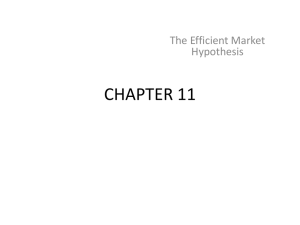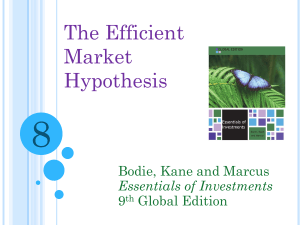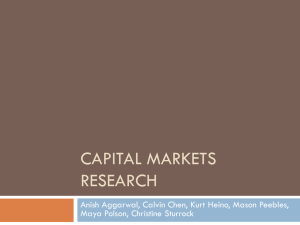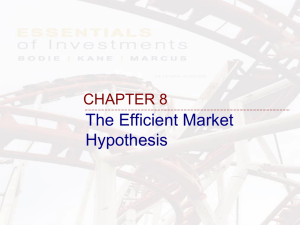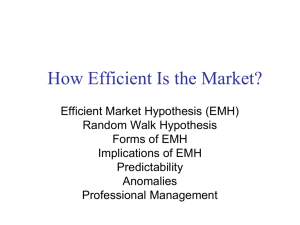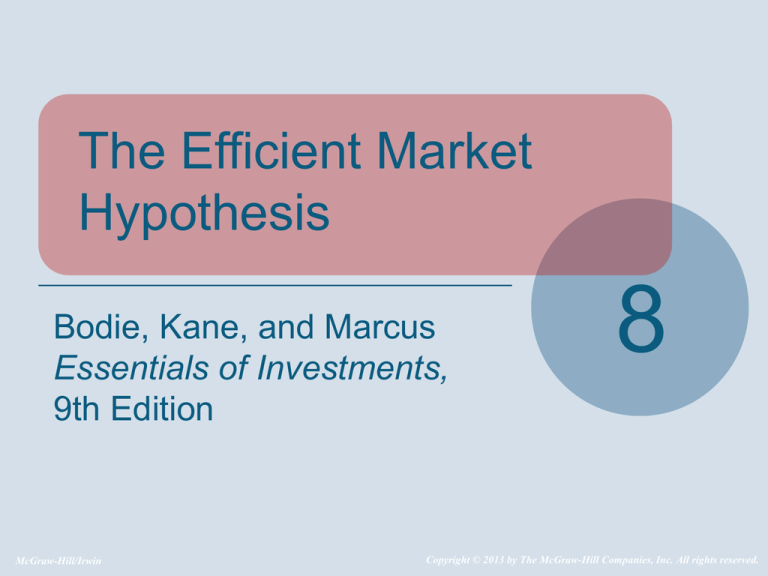
The Efficient Market
Hypothesis
Bodie, Kane, and Marcus
Essentials of Investments,
9th Edition
McGraw-Hill/Irwin
8
Copyright © 2013 by The McGraw-Hill Companies, Inc. All rights reserved.
8.1 Random Walks and Efficient Market Hypothesis
• Random Walk
• Notion that stock price changes are random
• Efficient Market Hypothesis (EMH)
• Prices of securities fully reflect available
information
8-2
Figure 8.1 Cumulative Abnormal Returns before Takeover
Attempts: Target Companies
8-3
Figure 8.2 Stock Price Reaction to CNBC Reports
8-4
8.1 Random Walks and Efficient Market Hypothesis
• Competition as Source of Efficiency
• Investor competition should imply stock prices
reflect available information
• Investors exploit available profit opportunities
• Competitive advantage can verge on insider
trading
8-5
8.1 Random Walks and Efficient Market Hypothesis
• Versions of EMH
• Weak-form EMH
• Stock prices already reflect all information
contained in history of trading
• Semistrong-form EMH
• Stock prices already reflect all public
information
• Strong-form EMH
• Stock prices already reflect all relevant
information, including inside information
8-6
8.2 Implications of the EMH
• Technical Analysis
• Research on recurrent/predictable price patterns
and on proxies for buy/sell pressure in market
• Resistance Level
• Unlikely for stock/index to rise above
• Support Level
• Unlikely for stock/index to fall below
8-7
Implications of the EMH
• Fundamental Analysis
• Research on determinants of stock value, i.e.
earnings, dividend prospects, future interest rate
expectations and firm risk
• Assumes stock price equal to discounted value
of expected future cash flow
8-8
Implications of the EMH
• Active versus Passive Portfolio Management
• Passive investment strategy
• Buying well-diversified portfolio without
attempting to find mispriced securities
• Index fund
• Mutual fund which holds shares in proportion to
market index representation
8-9
8.2 Implications of the EMH
• Role of Portfolio Management in Efficient
Market
• Active management assumes market inefficiency
• Passive management consistent with semistrong
efficiency
• Inefficient market pricing leads to inefficient
resource allocation
8-10
8.3 Are Markets Efficient?
• Issues
• Magnitude issue
• Efficiency is relative, not binary
• Selection bias issue
• Investors who find successful investment
schemes are less inclined to share findings
• Observable outcomes preselected in favor of
failed attempts
• Lucky event issue
• Lucky investments receive disproportionate
attention
8-11
8.3 Are Markets Efficient?
• Weak-Form Tests: Patterns in Stock Returns
• Returns over short horizons
• Momentum effect: Tendency of poorly- or well-
performing stocks to continue abnormal
performance in following periods
• Returns over long horizons
• Reversal effect: Tendency of poorly- or well-
performing stocks to experience reversals in
following periods
8-12
8.3 Are Markets Efficient?
• Predictors of Broad Market Performance
• 1988—Fama and French: Return on aggregate
stock market tends to be higher when dividend
yield is low
• 1988—Campbell and Shiller: Earnings yield can
predict market returns
• 1986—Keim and Stambaugh: Bond market data
(spread between yields) can predict market
returns
8-13
8.3 Are Markets Efficient?
• Semistrong Tests: Market Anomalies
• Anomalies
• Patterns of returns contradicting EMH
• P/E effect
• Portfolios of low P/E stocks exhibit higher
average risk-adjusted returns than high P/E
stocks
8-14
8.3 Are Markets Efficient?
• Semistrong Tests: Market Anomalies
• Small-firm effect
• Stocks of small firms can earn abnormal
returns, primarily in January
• Neglected-firm effect
• Stock of little-known firms can generate
abnormal returns
• Book-to-market effect
• Shares of high book-to-market firms can
generate abnormal returns
8-15
8.3 Are Markets Efficient?
• Semistrong Tests: Market Anomalies
• Post-earnings announcement price drift
• Sluggish response of stock price to firm’s
earnings announcement
• Abnormal return on announcement day,
momentum continues past market price
• Bubbles and market efficiency
• Speculative bubbles can raise prices above
intrinsic value
• Even if prices are inaccurate, it can be difficult
to take advantage of them
8-16
Figure 8.3 Average Annual Return: Ten Size-Based
Portfolios, 1926-2010
25
20
19.8
Annual return (%)
17.0
16.6
15.9
15.2
15
15.1
14.6
13.5
12.9
11.0
10
5
0
1
2
3
4
5
6
7
8
9
10
Size decile: 1 = small, 10 = large
8-17
Figure 8.4 Average Annual Return as Function of Bookto-Market Ratio, 1926-2010
20
18
17.3
16.1
15.5
Annual return (%)
16
14
12
11.8
11.7
2
3
11.0
13.1
13.4
13.4
5
6
7
11.7
10
8
6
4
2
0
1
4
8
9
10
Book-to-market decile: 1 = low, 10 = high
8-18
Figure 8.5 Cumulative Abnormal Returns after Earnings
Announcements
8-19
8.3 Are Markets Efficient?
• Interpreting Anomalies
• Risk premiums or inefficiencies?
• Fama and French: Market phenomena can be
explained as manifestations of risk premiums
• Lakonishok, Shleifer, and Vishny: Market
phenomena are evidence of inefficient markets
8-20
8.3 Are Markets Efficient?
• Interpreting Anomalies
• Anomalies or data mining?
• Some anomalies have not shown staying
power after being reported
• Small-firm effect
• Book-to-market effect
8-21
Figure 8.6 Return to Style Portfolio as Predictor of GDP
Growth
8-22
8.4 Mutual Fund and Analyst Performance
• Stock Market Analysis
• Analysts are overly positive about firm prospects
• Womack: Positive changes associated with 5%
increase, negative with 11% decrease
• Jegadeesh, Kim, Kristie, and Lee: Level of
consensus is inconsistent predictor of future
performance
• Barber, Lehavy, McNichols, and Trueman:
Firms with most-favorable recommendations
outperform firms with least-favorable
recommendations
8-23
8.4 Mutual Fund and Analyst Performance
• Mutual Fund Managers
• Today’s conventional model: Fama-French
factors plus momentum factor
• Wermers: Funds show positive gross alphas;
negative net alphas after controlling for fees, risk
• Carhart: Minor persistence in relative
performance across managers, largely due to
expense/transaction costs
8-24
8.4 Mutual Fund and Analyst Performance
• Mutual Fund Managers
• Berk and Green: Skilled managers with
abnormal performance will attract new funds
until additional cost, complexity drives alphas to
zero
• Chen, Ferson, and Peters: On average, bond
mutual funds outperform passive bond indexes
in gross returns, underperform once fees
subtracted
8-25
8.4 Mutual Fund and Analyst Performance
• Mutual Fund Managers
• Kosowski, Timmerman, Wermers, and White:
Stock-pricing ability of minority of managers
sufficient to cover costs; performance persists
over time
• Samuelson: Records of most managers show no
easy strategies for success
8-26
Figure 8.7 Mutual Fund Alphas Computed Using FourFactor Model, 1993-2007
8-27
Figure 8.8 Persistence of Mutual Fund Performance
8-28
Figure 8.9 Risk-Adjusted Performance in Ranking Quarter,
Following Quarter
8-29
8.4 Mutual Fund and Analyst Performance
• So, Are Markets Efficient?
• Enough that only differentially superior
information will earn money
• Professional manger’s margin of superiority
likely too slight for statistical significance
8-30

